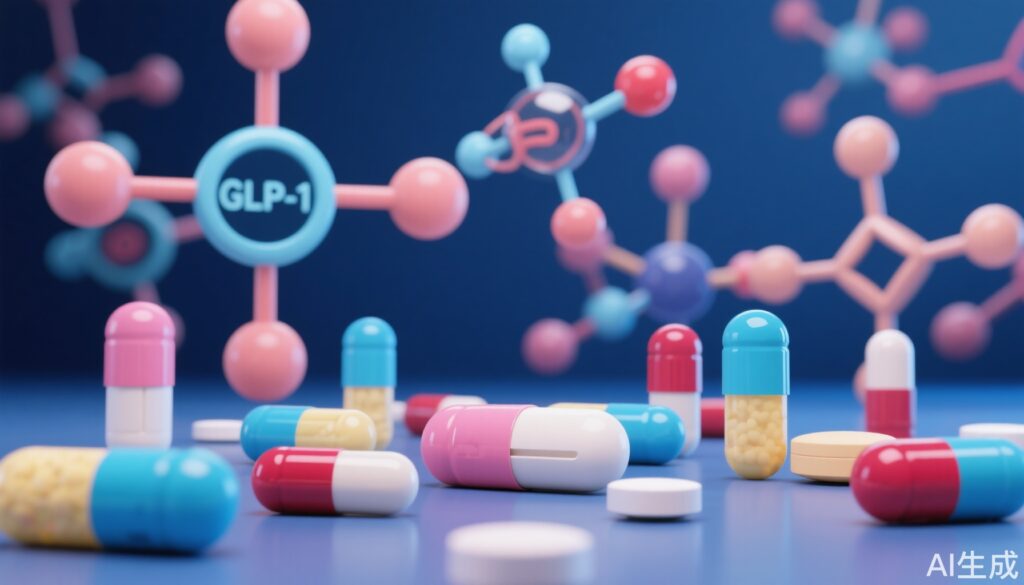Recent Phase III data positions Eli Lilly’s orforglipron as a pioneering oral GLP-1 therapy with 12.4% weight reduction at 72 weeks. However, emerging oral candidates from Novo Nordisk (amycretin), Viking Therapeutics (VK2735), Roche (CT-996), Terns Pharmaceuticals (TERN-601), and Rhythm Pharmaceuticals (bivamelagon) offer promising alternative mechanisms. These therapies may enhance patient convenience, address safety concerns, and potentially reshape the oral obesity treatment landscape.
Obesity remains a pervasive global health challenge linked to increased risk of diabetes, cardiovascular disease, and mortality. Despite advances in injectable GLP-1 receptor agonists leading to significant weight loss, barriers such as injection aversion, cost, and accessibility limit widespread adoption. Oral obesity drugs promise to address these hurdles by improving patient adherence and expanding therapeutic reach.
Orforglipron, developed by Eli Lilly, is a next-generation oral GLP-1 receptor agonist studied in the Phase III ATTAIN-1 trial. The study enrolled obese adults, randomized to receive varying doses of orforglipron or placebo, with primary endpoints assessing percent body weight change at 72 weeks. Similarly, other oral candidates such as Novo Nordisk’s amycretin (oral amylin analog), Viking Therapeutics’ VK2735 (oral GLP-1/GIP dual agonist), Roche’s CT-996 (biased GLP-1 agonist), Terns Pharmaceuticals’ TERN-601 (oral GLP-1 optimized for metabolic stability), and Rhythm Pharmaceuticals’ bivamelagon (melanocortin-4 receptor agonist) have undergone early to mid-stage clinical development with endpoints including weight loss efficacy, safety, and tolerability.
Eli Lilly’s Orforglipron: In ATTAIN-1, orforglipron induced an average 12.4% weight reduction at 72 weeks vs. 0.9% with placebo, with nearly 60% on the highest dose achieving ≥10% weight loss. Adverse events commonly included nausea, vomiting, and constipation, though tolerability was considered manageable for an oral agent.
Novo Nordisk’s Amycretin: As a dual GLP-1 and amylin receptor agonist, amycretin showed impressive efficacy in injectable form, with 22% weight loss at 20 weeks and up to 23.9% at 36 weeks. Its oral formulation, still in Phase I, demonstrated a 13.1% reduction at 12 weeks, with favorable safety.
Viking Therapeutics’ VK2735: This oral GLP-1/GIP agonist demonstrated 3.3% mean weight reduction at 28 days with 40 mg dosing, escalating to 8.2% at 100 mg. A Phase II trial is underway to validate longer-term efficacy and safety.
Roche’s CT-996: A biased GLP-1 agonist designed to retain efficacy while improving safety, CT-996 reduced body weight by 7.3% at 4 weeks vs. 1.2% with placebo. Safety concerns emerged with rapid dose escalation, notably nausea in 85%, but gradual titration improved tolerability. Roche plans Phase II studies later this year.
Terns Pharmaceuticals’ TERN-601: An oral GLP-1 receptor agonist optimized for pharmacokinetics and metabolic stability, TERN-601 showed a 4.9% placebo-adjusted weight loss over 28 days at 740 mg dosing. It features simplified dose titration and flexibility with food intake, currently in Phase II trials with topline data anticipated by year-end.
Rhythm Pharmaceuticals’ Bivamelagon: Targeting the melanocortin-4 receptor, a distinct pathway regulating appetite and energy expenditure, bivamelagon decreased BMI by 7.7% to 9.3% at doses of 400 mg and 600 mg over 14 weeks in patients with hypothalamic obesity, a rare condition. Adverse effects included serious events like rectal bleeding and hyperpigmentation. The drug is entering regulatory discussions for Phase III trial design.
Analysts and researchers acknowledge orforglipron’s leadership as the most advanced oral GLP-1 compound, particularly leveraging Lilly’s commercial strengths. However, the ATTAIN-1 results fell short of some expectations, leaving room for competition. Safety issues common to GLP-1-based therapies remain a challenge across oral candidates, especially gastrointestinal side effects that can affect adherence.
Novo Nordisk’s dual amylin and GLP-1 targeting approach offers promise for synergistic weight loss effects, potentially surpassing monotherapy efficacy. Viking’s and Terns’ molecules exemplify efforts to improve oral bioavailability and patient convenience through pharmacokinetic refinement.
Roche’s strategic acquisition of Carmot Therapeutics signals big pharma’s interest in oral small molecules with potentially better safety profiles. Rhythm’s bivamelagon adds novelty by addressing a mechanistically distinct receptor implicated in rare obesity syndromes, which may pave the way for combination therapies.
Oral obesity pharmacotherapies are poised to transform weight management by offering effective, convenient alternatives to injectable GLP-1 therapies. Eli Lilly’s orforglipron currently leads this wave, but promising candidates from Novo Nordisk, Viking Therapeutics, Roche, Terns Pharmaceuticals, and Rhythm Pharmaceuticals bring innovative mechanisms and clinical data that could reshape market dynamics. Despite observed safety signals, successful oral agents could expand treatment accessibility, improve adherence, and address diverse patient needs. Continued rigorous clinical evaluation, long-term safety assessment, and head-to-head comparisons will determine how these agents integrate into obesity care paradigms.
References
- Wilding JPH, et al. Efficacy and safety of orforglipron, a novel oral GLP-1 receptor agonist, in adults with obesity: results from the ATTAIN-1 Phase III study. Presented 2024.
- Madsbad S, et al. Dual agonism with amylin and GLP-1 receptor agonists: clinical potential in obesity. Diabetes Care. 2023;46(8):1578-1585.
- Frassetto LA, et al. Viking Therapeutics Phase I study of VK2735 oral formulation: pharmacokinetics, safety, and preliminary efficacy. ObesityWeek 2024 Abstract.
- Genentech. CT-996 development update and clinical profile. Roche Q2 Earnings Report 2024.
- McLaughlin T, et al. Safety and efficacy of TERN-601, an oral GLP-1 agonist with simplified titration in Phase I study. ADA 2024 Presentation.
- Smith SR, et al. Bivamelagon in hypothalamic obesity: Phase II trial outcomes and safety considerations. J Clin Endocrinol Metab. 2024;109(4):e1453-e1463.



